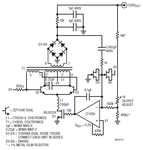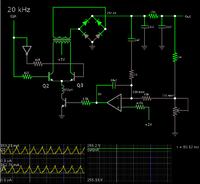narwhaler
Newbie level 6

- Joined
- Dec 7, 2012
- Messages
- 12
- Helped
- 0
- Reputation
- 0
- Reaction score
- 1
- Trophy points
- 1,281
- Activity points
- 1,426
I've been looking for a very low noise (less than a mV p-p) medium voltage (~100 V) variable DC supply circuit for a photodiode power supply I'm building. I found the attached circuit in an application note from Linear Technology (AN-118). It is a resonant royer converter and the author claims 100 uV of noise at a 250 V DC output. The low noise is achieved through the resonant nature of the converter, which eliminates high frequency harmonics due to hard switching. I'm looking for some help understanding the circuit design and how I can modify it for my needs.

1. I assume the "x2" in the schematic by Q2 refers to the dual npn ZDT1048 (easy questions first :-D)
2. As drawn, the feedback to the negative pin of A1 does not equal the reference voltage at the positive input. If you have 250 VDC out, and divide that down by 500/1E6, that leaves 0.125 VDC at the negative input of A1. The positive input of A1 is tied to the internal 0.2V reference. Won't this drive the output way above 250V?
3. (Related to question 2) What is the purpose of the separate feedback paths (the 1meg/500ohm divider and the 0.001uF/1k path) - why would it be designed this way?
4. If I wanted to make this a programmable output circuit, could I just control the voltage on the + input of A1 from 0 to 0.2 V to swing the output from 0-250 V? If I wanted a different maximum voltage, could I just change the transformer T1 out for one with a smaller turns ratio (T1 Ns/Np = 67), and/or just change the feedback voltage divider? What I'm ultimately after is a supply that I can vary from ~20-100V.
5. Short of building and testing, how could I begin to analyze how this circuit will perform over temperature?
Thanks!

1. I assume the "x2" in the schematic by Q2 refers to the dual npn ZDT1048 (easy questions first :-D)
2. As drawn, the feedback to the negative pin of A1 does not equal the reference voltage at the positive input. If you have 250 VDC out, and divide that down by 500/1E6, that leaves 0.125 VDC at the negative input of A1. The positive input of A1 is tied to the internal 0.2V reference. Won't this drive the output way above 250V?
3. (Related to question 2) What is the purpose of the separate feedback paths (the 1meg/500ohm divider and the 0.001uF/1k path) - why would it be designed this way?
4. If I wanted to make this a programmable output circuit, could I just control the voltage on the + input of A1 from 0 to 0.2 V to swing the output from 0-250 V? If I wanted a different maximum voltage, could I just change the transformer T1 out for one with a smaller turns ratio (T1 Ns/Np = 67), and/or just change the feedback voltage divider? What I'm ultimately after is a supply that I can vary from ~20-100V.
5. Short of building and testing, how could I begin to analyze how this circuit will perform over temperature?
Thanks!



